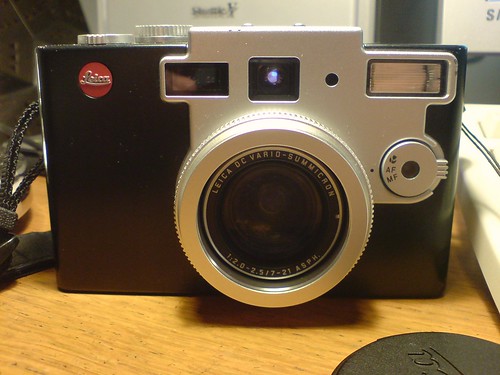Difference between revisions of "Leica Digilux 1"
(different photo view) |
m (fixed red relink to correct page title) |
||
| Line 13: | Line 13: | ||
''Note: The 2002 Digilux 1 should not be confused with the earlier [[Leica Digilux]], which had a vertically-oriented body and a non-zooming lens.'' | ''Note: The 2002 Digilux 1 should not be confused with the earlier [[Leica Digilux]], which had a vertically-oriented body and a non-zooming lens.'' | ||
| − | The '''Digilux 1''' represented an early move by ultra-traditionalist [[Leica]] into the world of digital cameras. This model was evidently a retooling of the [[Panasonic DMC-LC5]], a camera which shared the same Leica-branded 3x zoom lens and 3.9 megapixel sensor. The lens offered a maximum aperture of f/2.0–f/2.5, across its zoom range from 33–100 mm (in [[35mm equivalent]] terms). | + | The '''Digilux 1''' represented an early move by ultra-traditionalist [[Leica]] into the world of digital cameras. This model was evidently a retooling of the [[Panasonic Lumix DMC-LC5]], a camera which shared the same Leica-branded 3x zoom lens and 3.9 megapixel sensor. The lens offered a maximum aperture of f/2.0–f/2.5, across its zoom range from 33–100 mm (in [[35mm equivalent]] terms). |
==Links== | ==Links== | ||
Revision as of 01:21, 27 February 2013
This article is a stub. You can help Camera-wiki.org by expanding it.

|
| image by pocket.calculator (Image rights) |
Note: The 2002 Digilux 1 should not be confused with the earlier Leica Digilux, which had a vertically-oriented body and a non-zooming lens.
The Digilux 1 represented an early move by ultra-traditionalist Leica into the world of digital cameras. This model was evidently a retooling of the Panasonic Lumix DMC-LC5, a camera which shared the same Leica-branded 3x zoom lens and 3.9 megapixel sensor. The lens offered a maximum aperture of f/2.0–f/2.5, across its zoom range from 33–100 mm (in 35mm equivalent terms).
Links
- Specifications of Digilux 1 and Panasonic LC5 from DPReview.com

|
| image by Tim Robinson (Image rights) |